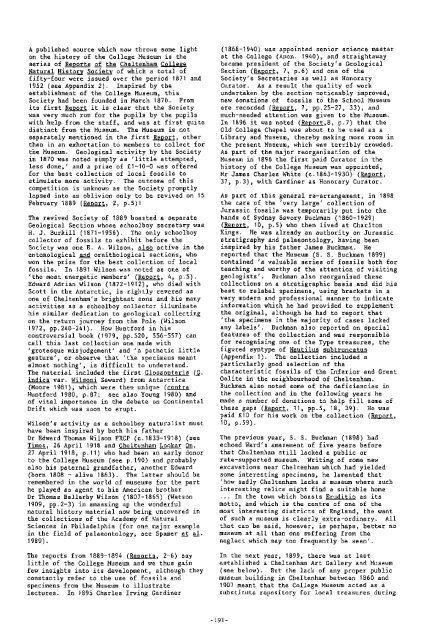Number 5 - Geological Curators Group
Number 5 - Geological Curators Group
Number 5 - Geological Curators Group
Create successful ePaper yourself
Turn your PDF publications into a flip-book with our unique Google optimized e-Paper software.
A published source which now throws some lighton the history of the College Museum is theseries of ReDorts of the Cheltenham ColleeeNatural Historv Society of which a total offifty-four were issued over the period 1871 and1952 (see Appendix 2). Inspired by theestablishment of the College Museum, thisSociety had been founded in March 1870. Fromits first it is clear that the Societywas very much run for the pupils by the pupilswith help from the staff, and was at first quitedistinct from the Museum. The Museum is notseparately mentioned in the first-, otherthan in an exhortation to members to collect forthe Museum. <strong>Geological</strong> activity by the Societyin 1870 was noted simply as 'little attempted,less done,' and a prize of £1-10-0 was offeredfor the hest collection of local fossils tostimulate more activity. The outcome of thiscompetition is unknown as the Society promptlylapsed into an oblivion only to be revived on 15February 1889 ( M , 2, p.5)!The revived Society of 1889 boasted a separate<strong>Geological</strong> Section whose schoolboy secretary wasH. J. Burkill (1871-1956). The only schoolboycollector of fossils to exhibit before theSociety was one E. A. Wilson, active in theentamological~ ornithological sections, whowon the prize far the best collection of localfossils. In 1891 Wilson was noted as one of'the most energetic members' (M, 4, p.5).Edward Adrian Wilsan (1872-1912), who died withScott in the Antarctic, is rightly revered asone of Cheltenham's brightest sons and his manyactivities as a schoolboy collector illuminatehis similar dedication to geological collectingon the return journey from the Pole (Wilson1972, pp.240-241). How Huntford in hiscontroversial book (1979, pp.520, 556-557) cancall this last collection one made with'grotesque misjudgement' and 'a pathetic littlegesture', or observe that 'the specimens meantalmost nothing', is difficult to understand.The material included the first Glosso~teris (G.var. Seward) from Antarctica(Moore 1981), which were then unique (WHuntford 1980, p.87; see also Young 1980) andof vital importance in the debate on ContinentalDrift which was soon to erupt.Wilsan's activity as a schoolboy naturalist musthave been inspired by both his fatherDr Edward Thomas Wilson FRCP (c.1833-1918) (seeTimes, 26 April 1918 and Cheltenham Looker On,27 April 1918, p.11) who had been an early donorto the College Museum (see p.190) and probablyalso his paternal grandfather, another Edward(born 1808 - alive 1863). The latter should heremembered in the world of museums for the parthe played as agent to his American brotherDr Thomas Bellerby Wilson (1807-1865) (Watson1909, pp.2-3) in amassing up the wonderfulnatural history material now being uncovered inthe collections of the Academy of NaturalSciences in Philadelphia (for one major examplein the field of palaeontology, see Spamer et al.1989).The reports from 1889-1894 (m, 2-6) saylittle of the College Museum and we thus gainfew insights into its development, although theyconstantly refer to the use of fossils andspecimens from the Museum to illustratelectures. In 1895 Charles Irving Gardiner(1868-1940) was appointed senior science masterat the College (Anon. 1940), and straightawaybecame president of the Society's <strong>Geological</strong>Section ( M , 7, p.6) and one of theSociety's Secretaries as well as HonoraryCurator. As a result the quality of workundertaken by the section noticeably improved,new donations of fossils to the School Museumare recorded ( M , 7, pp:25-27, 33), andmuch-needed attention was given to the Museum.In 1896 it was noted (-,B, p.7) that theOld College Chapel was about to be used as aLibrary and Museum, thereby making more room inthe present Museum, which was terribly crowded.As part of the major reorganisation of theMuseum in 1896 the first paid Curator in thehistory of the College Museum was appointed,Mr James Charles White (c.1863-1930)(M,37, p.3), with Gardiner as Honorary Curator.As part of this general re-arrangement, in 1898the care of the 'very large' collection ofJurassic fossils was temporarily put into thehands of Sydney Savory Buckman (1860-1929)(m, 10, p.5) who then lived at CharltonKings. He was already an authority on Jurassicstratigraphy and palaeontology, having beeninspired by his father James Buckman. Hereported that the Museum (S. S. Buckman 1899)contained 'a valuable series of fossils both forteaching and worthy of the attention of visitinggeologists'. Buckman also reorganised thesecollections on a stratigraphic basis and did hisbest to relabel specimens, using brackets in avery modern and professional manner to indicateinformation which he had provided to supplementthe original, although he had to report that'the specimens in the majority of cases lackedany labels'. Buckman also reported an specialfeatures of the collection and was responsiblefor recoenisine one of the Tvoe treasures. the.Afigured syntype of Nautilus subtruncatus(Appendix 1). The collection included apa;iicularly good selection of thecharacteristic fossils of the Inferior and GreatOolite in the neighbourhood of Cheltenham.Buckman also noted some of the deficiencies inthe collection and in the following years hemade a number of donations to help fill same ofthese gaps ( M , 11, pp.5, 18, 39). He waspaid £10 for his work on the collection ( m ,ro, p.59).The previous year, S. S. Buckman (1898) hadechoed Ward's amazement of five years beforethat Cheltenham still lacked a public orrate-supported museum. Writing of some newexcavations near Cheltenham which had yieldedsome interesting specimens, he lamented that'how sadly Cheltenham lacks a museum where suchinteresting relics might find a suitable home... In the town which boasts Eruditio as itsmotto, and which is the centre of one of themost interesting districts of England, the wantof such a museum is clearly extra-ordinary. Allthat can be said, however, is perhaps, better nomuseum at all than one suffering from theneglect which may too frequently he seen'.In the next year, 1899, there was at lastestablished a Cheltenham Art Gallery and Museum(see below). But the lack of any proper publicmuseum building in Cheltenham between 1860 and1907 meant that the College Museum acted as asubstitute repository for local treasures during
















